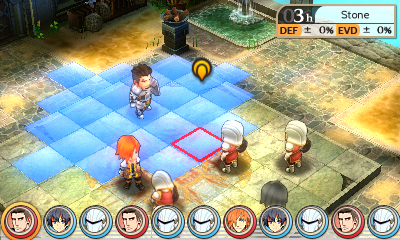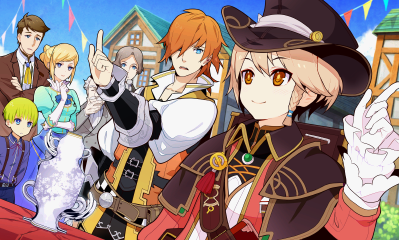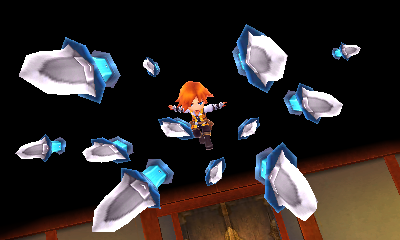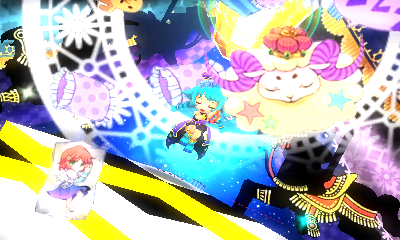
Title: Stella Glow
Developer/Publisher: Imageepoch/Atlus
Release Date: November 17th, 2015
Price: $49.99
Stella Glow’s heavy emphasis on song might mislead the casual observer to believe that Imageepoch’s last game has rhythm elements. It doesn’t. It’s a straightforward strategy RPG through and through, set in a world where humans have lost the ability to sing. Only witches can sing, and their songs are pretty much spells.
Stella Glow’s story starts out as cliche as you please: our hero, Alto, ends up in a village after he loses all his memories and is taken in by Lisette and her mother Rosa. For three years everything is fine and dandy: hunting wolves for their meat, having quiet birthday dinners and generally being content. One day, Alto wakes up to hear someone singing, and who else should it be but the Witch of Destruction, Hilda, come to destroy his village. In his hopeless revenge-battle against Hilda and her right-hand man, Dante, the necklace he gave to Lisette causes her witch powers to awaken. As the story progresses, Alto and Lisette join the royal knights and team up with the remaining witches to defeat Hilda and reverse the destruction she caused.

Stella Glow is so cutscene-heavy that it almost doubles as a visual novel. The characters do a lot of talking, sometimes being grating the way they have to go through a few pieces of ‘What?’ ‘So – so you mean that…’ dialogue to get what anyone watching would grasp immediately. In fact, there are so many long cutscenes that more than a few times, when my 3DS’s LED was flashing red, I wished the game had an option to quicksave in the middle of a cutscene like visual novels have.
The localization is very impressive, though: almost all of the story cutscenes and about two-thirds of the non-essential ones are voiced in English. Most of the voice-acting is well done, apart from the parts where it was impossible to not sound forced (try saying different versions of ‘Wh-what’s happening?’ in quick succession yourself and see) and some of the stuff the characters shout while attacking: it’s hard to sound believable while speaking lines as corny as, “Now it’s time for you … to die!” and, “You shall take this attack!” Those parts aside though, the voice acting is commendable. The voice talents for Rusty, Mordimort and Archibald in particular did magnificently, but it was side character Regent Elmar’s voice actor who gave the best performance of the lot.


Your characters can use skills which cost SP, and most of these are powerful attacks so you should always start on a fresh enemy with a skill attack. Each attack earns experience for your character and levelling up refills their HP and SP, so you shouldn’t hesitate to expend SP. The game gets the difficulty just right – it leans towards the easy side if anything. Only a couple of missions are difficult enough to take even two tries. Most of them can be beaten with only one ally at most falling. As long as you follow the ‘Disgaea rules’ – attack from behind, don’t hesitate to use items, level up your party evenly and (most importantly of all) gang up on bosses – you’ll do fine.
Special items called Orbs can be attached to weapons to make them more powerful under certain conditions, imbue them with the power to inflict status ailments or grant them elemental effects. Elements make certain characters super-effective against other types: water overpowers fire, earth is susceptible to wind, and so on. With the exception of certain locations, most enemies are non-elemental, so it feels like an afterthought.
Alto is a Conductor, which means he can help witches sing when they are next to him in battle. These songs strengthen your allies and inflict status ailments on every single enemy on the map – quite often, they turn the tide of battle your way if you’re losing. These songs, which are the only part of the voices left in Japanese, also become the battle’s background music as long as the effects prevail. They’re all very enjoyable, especially if you like Vocaloid music. In fact, Mordimort’s ‘Reddened Galaxy’ sounded so much like a Vocaloid song that I wondered if it actually was one.
The colour palette in Stella Glow is vibrant. Characters on the isometric battle maps look sleek, but a couple of maps are really small and a few of the bigger ones are too empty. During attacks, the view switches to a 3D animation of your character putting the hurt on their foe. The 3D versions of the characters look like Nendoroids. They aren’t smooth, but they’re well-animated.
The background music in Stella Glow is great, but there isn’t enough of it. You’ll be hearing the same tracks a lot so later on in the game several tracks feel overused. Some more music, if switched now and then with the tracks in question, would have kept them from going stale.
A single playthrough of Stella Glow lasts a bit over 40 hours. There isn’t a lot of incentive to start a second one soon after the first. There are multiple secondary endings, but although there’s a true ending instead of the normal one, it’s quite possible you’ll get the true ending on the first go. After that, you’ll want to put the game away for a good while, like you would with any story-heavy RPG. Stella Glow has some shortcomings and it’s not really innovative either, but it was still a fun 40 hours.
Overall Score: 7/10